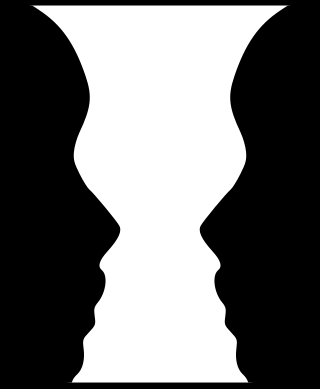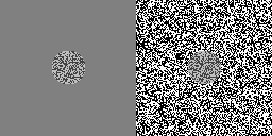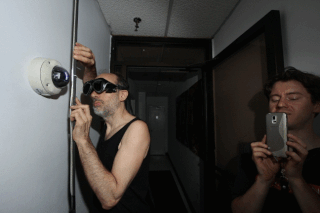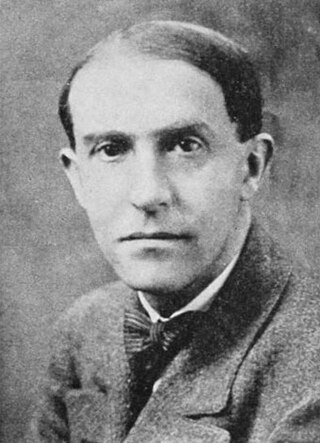Persistence of vision is the optical illusion that occurs when the visual perception of an object does not cease for some time after the rays of light proceeding from it have ceased to enter the eye. The illusion has also been described as "retinal persistence", "persistence of impressions", simply "persistence" and other variations. A very commonly given example of the phenomenon is the apparent fiery trail of a glowing coal or burning stick while it is whirled around in the dark.

In visual perception, an optical illusion is an illusion caused by the visual system and characterized by a visual percept that arguably appears to differ from reality. Illusions come in a wide variety; their categorization is difficult because the underlying cause is often not clear but a classification proposed by Richard Gregory is useful as an orientation. According to that, there are three main classes: physical, physiological, and cognitive illusions, and in each class there are four kinds: Ambiguities, distortions, paradoxes, and fictions. A classical example for a physical distortion would be the apparent bending of a stick half immerged in water; an example for a physiological paradox is the motion aftereffect. An example for a physiological fiction is an afterimage. Three typical cognitive distortions are the Ponzo, Poggendorff, and Müller-Lyer illusion. Physical illusions are caused by the physical environment, e.g. by the optical properties of water. Physiological illusions arise in the eye or the visual pathway, e.g. from the effects of excessive stimulation of a specific receptor type. Cognitive visual illusions are the result of unconscious inferences and are perhaps those most widely known.
Gestalt psychology, gestaltism, or configurationism is a school of psychology that emerged in the early twentieth century in Austria and Germany as a theory of perception that was a rejection of basic principles of Wilhelm Wundt's and Edward Titchener's elementalist and structuralist psychology.

The term phi phenomenon is used in a narrow sense for an apparent motion that is observed if two nearby optical stimuli are presented in alternation with a relatively high frequency. In contrast to beta movement, seen at lower frequencies, the stimuli themselves do not appear to move. Instead, a diffuse, amorphous shadowlike something seems to jump in front of the stimuli and occlude them temporarily. This shadow seems to have nearly the color of the background. Max Wertheimer first described this form of apparent movement in his habilitation thesis, published 1912, marking the birth of Gestalt psychology.

Max Wertheimer was a psychologist who was one of the three founders of Gestalt psychology, along with Kurt Koffka and Wolfgang Köhler. He is known for his book, Productive Thinking, and for conceiving the phi phenomenon as part of his work in Gestalt psychology.
Apparent motion may refer to:

The Ternus illusion, also commonly referred to as the Ternus Effect, is an illusion related to human visual perception involving apparent motion. In a simplified explanation of one form of the illusion, two discs, are shown side by side as the first frame in a sequence of three frames. Next a blank frame is presented for a very short, variable duration. In the final frame, two similar discs are then shown in a shifted position. Depending on various factors including the time intervals between frames as well as spacing and layout, observers perceive either element motion, in which L appears to move to R while C remains stationary or they report experiencing group motion, in which L and C appear to move together to C and R. Both element motion and group motion can be observed in animated examples to the right in Figures 1 and 2.

The stroboscopic effect is a visual phenomenon caused by aliasing that occurs when continuous rotational or other cyclic motion is represented by a series of short or instantaneous samples at a sampling rate close to the period of the motion. It accounts for the "wagon-wheel effect", so-called because in video, spoked wheels sometimes appear to be turning backwards.

Figure–ground organization is a type of perceptual grouping that is a vital necessity for recognizing objects through vision. In Gestalt psychology it is known as identifying a figure from the background. For example, black words on a printed paper are seen as the "figure", and the white sheet as the "background".

The term illusory motion, also known as motion illusion or "apparent motion", is an optical illusion in which a static image appears to be moving due to the cognitive effects of interacting color contrasts, object shapes, and position. The stroboscopic animation effect is the most common type of illusory motion and is perceived when images are displayed in fast succession, as occurs in movies. The concept of illusory motion was allegedly first described by Aristotle.

Motion perception is the process of inferring the speed and direction of elements in a scene based on visual, vestibular and proprioceptive inputs. Although this process appears straightforward to most observers, it has proven to be a difficult problem from a computational perspective, and difficult to explain in terms of neural processing.
The interstimulus interval is the temporal interval between the offset of one stimulus to the onset of another. For instance, Max Wertheimer did experiments with two stationary, flashing lights that at some interstimulus intervals appeared to the subject as moving instead of stationary. In these experiments, the interstimulus interval is simply the time between the two flashes. The ISI plays a large role in the phi phenomenon (Wertheimer) since the illusion of motion is directly due to the length of the interval between stimuli. When the ISI is shorter, for example between two flashing lines alternating back and forth, we perceive the change in stimuli to be movement. Wertheimer discovered that the space between the two lines is filled in by our brains and that the faster the lines alternate, the more likely we are to perceive it as one line moving back and forth. When the stimuli move fast enough, this creates the illusion of a moving picture like a movie or cartoon. Phi phenomenon is very similar to beta movement.

The lilac chaser is a visual illusion, also known as the Pac-Man illusion. It consists of 12 lilac, blurred discs arranged in a circle, around a small black, central cross on a grey background. One of the discs disappears briefly, then the next, and the next, and so on, in a clockwise direction. When one stares at the cross for at least 30 seconds, one sees three illusions
- A gap running around the circle of lilac discs;
- A green disc running around the circle of lilac discs in place of the gap; and
- The green disc running around on the grey background, with the lilac discs having disappeared in sequence.
The kappa effect or perceptual time dilation is a temporal perceptual illusion that can arise when observers judge the elapsed time between sensory stimuli applied sequentially at different locations. In perceiving a sequence of consecutive stimuli, subjects tend to overestimate the elapsed time between two successive stimuli when the distance between the stimuli is sufficiently large, and to underestimate the elapsed time when the distance is sufficiently small.

The color phi phenomenon is the fact that, when apparent motion is induced between objects with different colors, the color of the apparently moving object abruptly changes midway along the path. It is a perceptual illusion described by psychologists Paul Kolers and Michael von Grünau in which a disembodied perception of motion is produced by a succession of still images. The color phi phenomenon is a more complex variation of the phi phenomenon. Kolers and von Grünau originally investigated the phenomenon in response to a question posed by the philosopher Nelson Goodman, who asked what the effect of the color change would have on the phi phenomenon.

The flash lag illusion or flash-lag effect is a visual illusion wherein a flash and a moving object that appear in the same location are perceived to be displaced from one another. Several explanations for this simple illusion have been explored in the neuroscience literature.

The Chubb illusion is an optical illusion or error in visual perception in which the apparent contrast of an object varies substantially to most viewers depending on its relative contrast to the field on which it is displayed. These visual illusions are of particular interest to researchers because they may provide valuable insights in regard to the workings of human visual systems.

Light writing is an emerging form of stop motion animation wherein still images captured using the technique known as light painting or light drawing are put in sequence thereby creating the optical illusion of movement for the viewer.
In psychophysics, Korte's third law of apparent motion is an observation relating the phenomenon of apparent motion to the distance and duration between two successively presented stimuli.

Kurt Koffka was a German psychologist and professor. He was born and educated in Berlin, Germany; he died in Northampton, Massachusetts, from coronary thrombosis. He was influenced by his maternal uncle, a biologist, to pursue science. He had many interests including visual perception, brain damage, sound localization, developmental psychology, and experimental psychology. He worked alongside Max Wertheimer and Wolfgang Köhler to develop Gestalt psychology. Koffka had several publications including "The Growth of the Mind: An Introduction to Child Psychology" (1924) and "The Principles of Gestalt Psychology" (1935) which elaborated on his research.


















